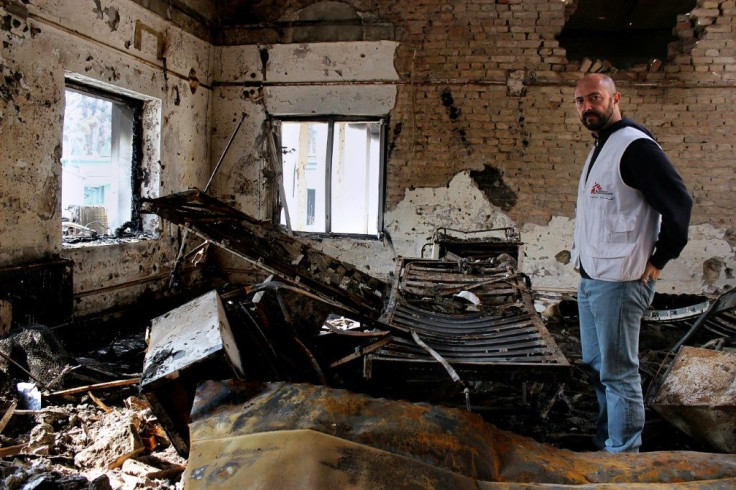The 'French Doctors' Who Came To The Aid Of Soviet-occupied Afghans
Slowly the caravan of heavily loaded-up horses and mules snakes its way around the snow-capped peaks of northeastern Afghanistan.
Silent but for the clip-clop of the animals' hooves on the stone pathways, the scene was captured on film in 1986 as a handful of French doctors and nurses brought supplies and medical care to the war-torn country.
With four tonnes of medicine and equipment in tow, they were to set up two field hospitals for Doctors Without Borders (MSF) under the noses of the Afghan government and occupying Soviet forces.
Founded just 15 years earlier, the organisation's work in the valleys of Badakhshan or Panjshir under bombardment from Soviet MiGs has become an almost legendary part of its 50-year history.
"We managed to practise medicine in what was at the time a health desert and a country at war," said French anaesthetic nurse Regis Lansade, now aged 65.
The scenes filmed in 1986 by Juliette Fournot, the MSF head of mission for Afghanistan for a decade, were included in her 2006 documentary "A Ciel Ouvert" (Under an Open Sky).
MSF teams first went into Afghanistan shortly after its invasion in 1979 by Soviet forces, when a mass exodus of people fled towards neighbouring Pakistan to escape the deadly repression by the Soviets.
Within weeks, a million refugees had gathered in tribal border regions.
MSF geared up to go into Afghanistan to help -- but would have to do so secretly as the organisation had been banned by both Islamabad and Kabul.
"It didn't take long to decide" whether to go, said Claude Malhuret, MSF president at the time, pointing out that the organisation was founded with the aim of going wherever medical care was needed.
Fournot, also one of the scouts for the NGO, recalled that it was indeed an issue of debate.
"MSF was quite reticent for security reasons," she told AFP.
However, she and a French doctor who were leading the mission thought it was doable, as most of the country had been liberated, with the Soviets only controlling the towns and main roads, she said.
"In addition, the Afghans needed our help and were ready to accompany us."
Having made the decision, planning was now crucial, but challenging.
"The logistics were an absolute headache. It required a lot of time," Fournot, who spent her teens in Afghanistan with her engineer father, said.
"We had to build a network of reliable people whom we could count on."
Horses and mules had to be bought, equipment readied and decisions made on who would go with the team -- every mission needs several months of planning and negotiation.
Finally, they set off from Peshawar in northern Pakistan.
"We crossed the border at night at the most discreet point. We had a month of walking, with five or six mountain passes of an altitude of between 4,000 and 6,000 metres," Lansade said.
"On the first one we were really panting, by the last, we were running."
Once in place, the field hospital had to be able to function autonomously, sometimes for a year.
And in regions that had not seen a doctor for years, the health needs were huge.

"Some patients were travelling on foot or by horse for 10 days to reach us," Fournot said.
MSF was treating the war wounds of both mujahideen fighters and civilians in sometimes extremely difficult conditions.
They also treated everyday illnesses, while female staff provided gynaecological, obstetric and paediatric care too.
At the time, one in seven Afghan women died in childbirth and one in three children died before the age of five.
Security remained a constant concern.
"We were under the umbrella of tribal groups or political parties so that they ensured our protection," Fournot said.
"We were not neutral but it was important to be impartial, to show that we were caring for everyone."
She said that at the start, they decided to keep silent and not speak out against the Soviets, believing discretion would help them become more accepted.
But, in 1985, one of the teams was attacked, she said. "So we ended the silence since it was no longer protecting us."
At the time, few journalists were covering the war in Afghanistan, so when MSF staff spoke out about what was happening on the ground, it did not go unnoticed.
Its leaders were invited to speak publicly including before the US Congress.
Over the years, MSF has withdrawn from Afghanistan several times after attacks, but later returned.
Now, as the United States is withdrawing its remaining troops from the country, the picture of MSF's time there overall is a mixed one.
In 2015, an MSF hospital in the northern province of Kunduz was destroyed by a US airstrike in which 42 people were killed.
And last year, rampaging gunmen attacked a Kabul hospital maternity ward then run by MSF, killing 16 mothers.
"These tragic events show that MSF's presence in Afghanistan as a medical, humanitarian actor alongside the population is never straightforward," Emmanuel Tronc, head of missions from 1997 to 2016, said.
But it's the period under Soviet occupation that many still hark back to, an era when MSF teams were treating up to 10,000 patients a month, according to Fournot.
"And bearing witness was fundamental," she added.
Lansade said that Afghans at the time had felt that French doctors were the only foreigners helping them.
Both have lasting memories.
While the image of doctors on horseback in the Afghan mountains is appealing, Fournot said that in reality there was nothing "romantic" about it.
"It was dangerous and we had a hard time."
If some are nostalgic for a so-called golden age of relief work, she prefers to think of it as mission accomplished.
"In 10 years, more than 500 expatriate staff went into Afghanistan. They all came home again."
© Copyright AFP 2024. All rights reserved.





















